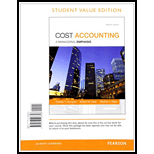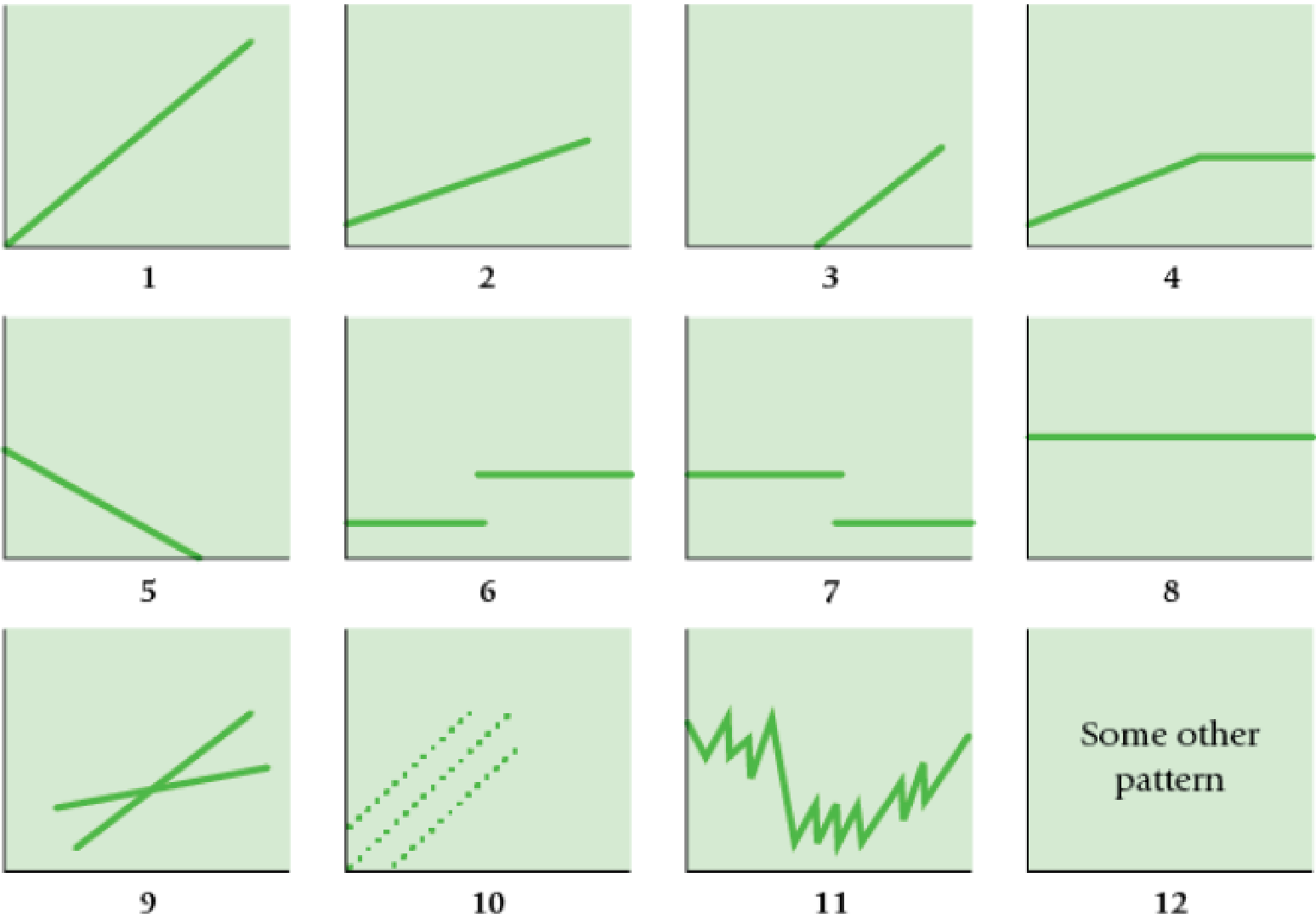
Concept explainers
Matching graphs with descriptions of cost and revenue behavior. (D. Green, adapted) Given here are a number of graphs.

The horizontal axis of each graph represents the units produced over the year, and the vertical axis represents total cost or revenues.
Indicate by number which graph best fits the situation or item described (a–h). Some graphs may be used more than once; some may not apply to any of the situations.
Required
- a. Direct material costs
- b. Supervisors’ salaries for one shift and two shifts
- c. A cost–volume–profit graph
- d. Mixed costs—for example, car rental fixed charge plus a rate per mile driven
- e.
Depreciation of plant, computed on a straight-line basis - f. Data supporting the use of a variable-cost rate, such as
manufacturing labor cost of $14 per unit produced - g. Incentive bonus plan that pays managers $0.10 for every unit produced above some level of production
- h. Interest expense on $2 million borrowed at a fixed rate of interest
Learn your wayIncludes step-by-step video

Chapter 10 Solutions
Cost Accounting, Student Value Edition Plus MyAccountingLab with Pearson eText -- Access Card Package (15th Edition)
Additional Business Textbook Solutions
Financial Accounting (12th Edition) (What's New in Accounting)
Fundamentals of Management (10th Edition)
Financial Accounting, Student Value Edition (5th Edition)
Horngren's Financial & Managerial Accounting, The Financial Chapters (Book & Access Card)
Gitman: Principl Manageri Finance_15 (15th Edition) (What's New in Finance)
- Davenport Industries is working on its direct labor budget for the next two months. Each unit of output requires 0.48 direct labor hours. The direct labor rate is $9.20 per direct labor hour. The production budget calls for producing 7,200 units in July and 7,800 units in August. If the direct labor workforce is fully adjusted to the total direct labor hours needed each month, what would be the total combined direct labor cost for the two months?arrow_forwardWhat was the dollar amount of underallocated or overallocated manufacturing overhead?arrow_forwardThe following monthly data are taken from Ramirez Company at July 31: Sales salaries, $520,000; Office salaries, $104,000; Federal income taxes withheld, $156,000; State income taxes withheld, $35,000; Social security taxes withheld, $38,688; Medicare taxes withheld, $9,048; Medical insurance premiums, $12,500; Life insurance premiums, $9,500; Union dues deducted, $6,500; and Salaries subject to unemployment taxes, $61,000. The employee pays 40% of medical and life insurance premiums. Assume that FICA taxes are identical to those on employees and that SUTA taxes are 5.4% and FUTA taxes are 0.6%. 1. & 2. Using the above information, complete the below table and prepare the journal entries to record accrued payroll, including employee deductions, and cash payment of the net payroll (salaries payable) for July. 3. Using the above information, complete the below table. 4. Record the accrued employer payroll taxes and other related employment expenses and the cash payment of all liabilities…arrow_forward
- At the beginning of the year, Vanguard Systems, Inc. determined that estimated overhead costs would be $720,000, while actual overhead costs for the year totaled $770,000. Furthermore, it was determined that the estimated allocation basis would be 75,000 direct labor hours, while direct laborers actually worked 78,000 hours. What was the dollar amount of underallocated or overallocated manufacturing overhead?arrow_forwardWhat are impaired assets and its pros and cons?arrow_forwardMing Chen started a business and had the following transactions in June. a. Owner invested $60,000 cash in the company along with $15,000 of equipment. b. The company paid $2,000 cash for rent of office space for the month. c. The company purchased $18,000 of additional equipment on credit (payment due within 30 days). d. The company completed work for a client and immediately collected $1,600 cash. e. The company completed work for a client and sent a bill for $7,300 to be received within 30 days. f. The company purchased additional equipment for $5,000 cash. g. The company paid an assistant $2,400 cash as wages for the month. h. The company collected $4,500 cash as a partial payment for the amount owed by the client in transaction e. i. The company paid $18,000 cash to settle the liability created in transaction c. j. The owner withdrew $1,500 cash from the company for personal use.arrow_forward
 Principles of Cost AccountingAccountingISBN:9781305087408Author:Edward J. Vanderbeck, Maria R. MitchellPublisher:Cengage Learning
Principles of Cost AccountingAccountingISBN:9781305087408Author:Edward J. Vanderbeck, Maria R. MitchellPublisher:Cengage Learning Managerial Accounting: The Cornerstone of Busines...AccountingISBN:9781337115773Author:Maryanne M. Mowen, Don R. Hansen, Dan L. HeitgerPublisher:Cengage Learning
Managerial Accounting: The Cornerstone of Busines...AccountingISBN:9781337115773Author:Maryanne M. Mowen, Don R. Hansen, Dan L. HeitgerPublisher:Cengage Learning Managerial AccountingAccountingISBN:9781337912020Author:Carl Warren, Ph.d. Cma William B. TaylerPublisher:South-Western College Pub
Managerial AccountingAccountingISBN:9781337912020Author:Carl Warren, Ph.d. Cma William B. TaylerPublisher:South-Western College Pub Financial And Managerial AccountingAccountingISBN:9781337902663Author:WARREN, Carl S.Publisher:Cengage Learning,
Financial And Managerial AccountingAccountingISBN:9781337902663Author:WARREN, Carl S.Publisher:Cengage Learning, Financial & Managerial AccountingAccountingISBN:9781285866307Author:Carl Warren, James M. Reeve, Jonathan DuchacPublisher:Cengage Learning
Financial & Managerial AccountingAccountingISBN:9781285866307Author:Carl Warren, James M. Reeve, Jonathan DuchacPublisher:Cengage Learning Excel Applications for Accounting PrinciplesAccountingISBN:9781111581565Author:Gaylord N. SmithPublisher:Cengage Learning
Excel Applications for Accounting PrinciplesAccountingISBN:9781111581565Author:Gaylord N. SmithPublisher:Cengage Learning





